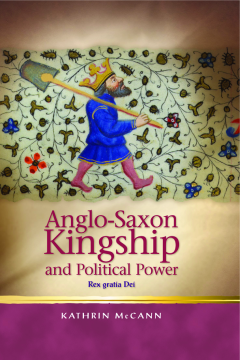
Additional Information
Book Details
Abstract
Works on Anglo-Saxon kingship often take as their starting point the line from Beowulf: ‘that was a good king’. This monograph, however, explores what it means to be a king, and how kings defined their own kingship in opposition to other powers. Kings derived their royal power from a divine source, which led to conflicts between the interpreters of the divine will (the episcopate) and the individual wielding power (the king). Demonstrating how Anglo-Saxon kings were able to manipulate political ideologies to increase their own authority, this book explores the unique way in which Anglo-Saxon kings understood the source and nature of their power, and of their own authority.
Table of Contents
| Section Title | Page | Action | Price |
|---|---|---|---|
| Cover\r | Cover Page | ||
| Title Page\r | 3 | ||
| Copyright Page | 4 | ||
| Contents\r | 5 | ||
| Series Editors’ Preface | 7 | ||
| Acknowledgements | 9 | ||
| List of Abbreviations | 11 | ||
| Timeline of events | 13 | ||
| Introduction | 17 | ||
| From Filius Ecclesiae to Defensor Ecclesiae | 19 | ||
| Emancipated Kings or Bishops’ Bailiffs? | 22 | ||
| Conclusion | 25 | ||
| Chapter 1: Early Anglo-Saxon Politics | 33 | ||
| Case Study I: Joint Kingship (Essex) | 37 | ||
| Case Study II: Overlordship (Sussex) | 39 | ||
| Case Study III: Conquest and Coinage (Mercia) | 41 | ||
| Case Study IV: Kingship and Legislation (Kent) | 44 | ||
| Case Study V: Royal Education (East Anglia) | 46 | ||
| Case Study VI: Abdicating Kings (Wessex) | 49 | ||
| Case Study VII: Saintly Royalty (Northumbria) | 51 | ||
| Conclusion | 54 | ||
| Chapter 2: Diploma Politicum | 63 | ||
| The Functional Title in the Royal Styles | 68 | ||
| The Legitimation Formula in the Royal Styles | 81 | ||
| Conclusion | 88 | ||
| Chapter 3: The Anglo-Saxon Regina Gratia Dei | 103 | ||
| Queenly Behaviour | 104 | ||
| Throneworthy Queens | 105 | ||
| Queenly Power | 109 | ||
| Conclusion | 110 | ||
| Chapter 4: Reformers and Rulers | 115 | ||
| Ecclesiastical Politics I: Edgar – Royal Action | 116 | ||
| Ecclesiastical Politics II: Æthelred – Divine Retribution | 121 | ||
| Ecclesiastical Politics III: From Speculum Principis to Speculum Societatis | 126 | ||
| Conclusion | 130 | ||
| Chapter 5: Rituals of King-making | 139 | ||
| The Development of the Royal Consecration Ritual | 140 | ||
| The Anglo-Saxon Consecration Ritual | 144 | ||
| Edgar’s Coronation | 150 | ||
| Visualising Rituals: Art and Architecture | 153 | ||
| Conclusion | 157 | ||
| Conclusion | 167 | ||
| Appendices | 171 | ||
| Appendix 1: Anglo-Saxon Kings | 171 | ||
| Appendix 2: Anglo-Saxon Archbishops | 181 | ||
| Appendix 3: Charter Elements | 183 | ||
| Tables | 186 | ||
| Table 1. Royal Styles | 186 | ||
| Table 2. Frequency of Legitimation Formulas | 191 | ||
| Table 3. Variants of Legitimation Formulas | 193 | ||
| Table 4. Historical Context | 200 | ||
| Table 5. Consecration Vocablary in Charters | 204 | ||
| Bibliography | 207 | ||
| Primary Texts | 207 | ||
| Secondary texts | 211 | ||
| Websites | 222 | ||
| Person Index | 223 | ||
| Index | 227 | ||
| Back Cover | Back Cover |
